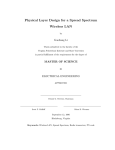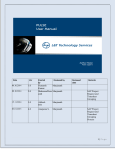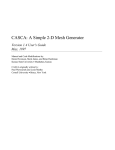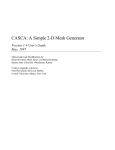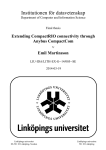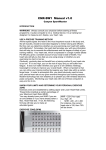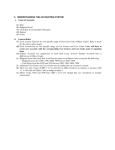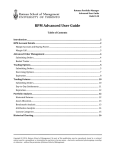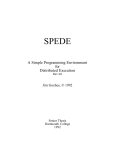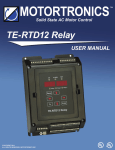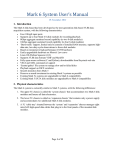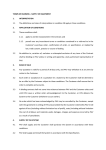Download nasdaq dubai operating procedures clearing and risk management
Transcript
NASDAQ DUBAI OPERATING PROCEDURES CLEARING AND RISK MANAGEMENT FOR DERIVATIVES MARKET March 2013 Ver1.6 CONTENTS 1. INTRODUCTION .................................................................................................................................................... 3 2. CLEARING SYSTEM ............................................................................................................................................. 5 3. OPERATING PROCEDURES FOR CLEARING OPERATIONS .......................................................................... 5 3.1 3.2 3.3 3.4 3.5 3.6 3.7 3.8 3.9 3.10 3.11 3.12 Types of Clearing Membership ............................................................................................................... 5 Accounts ................................................................................................................................................. 6 Transactions eligible for clearing ............................................................................................................ 6 NASDAQ Dubai as a CCP ...................................................................................................................... 6 Trade Cancellation .................................................................................................................................. 7 Give up-take up transactions .................................................................................................................. 7 Match outs .............................................................................................................................................. 7 Unwinding of match outs ........................................................................................................................ 8 Manual allocation .................................................................................................................................... 8 Clearing Operations ................................................................................................................................ 8 Market Calendar (Clearing and settlement) .......................................................................................... 10 Trading Member - Clearing Member association ................................................................................. 10 4. MARGIN REQUIREMENTS ................................................................................................................................. 10 4.1 4.2 4.3 4.4 4.5 4.6 4.7 4.8 4.9 4.10 4.11 4.12 4.13 Initial Margin (SPAN margin) ................................................................................................................ 10 Additional Margin .................................................................................................................................. 11 Margin Call ............................................................................................................................................ 11 Margin timelines .................................................................................................................................... 12 Intra-Day Margin ................................................................................................................................... 12 Eligible Margin ...................................................................................................................................... 12 Concentration Limits on Eligible Margin ............................................................................................... 12 Valuation of Eligible Margin .................................................................................................................. 13 Collateral Submission ........................................................................................................................... 13 Margin Release ..................................................................................................................................... 13 Interest on Cash Margin ....................................................................................................................... 13 Daily Settlement Prices ......................................................................................................................... 14 Final Settlement Prices ......................................................................................................................... 14 5. OPERATING PROCEDURES FOR SETTLEMENT OPERATIONS ................................................................... 15 5.1 5.1.1 5.1.2 5.2 5.3 5.4 5.5 5.6 Introduction to the settlement model .................................................................................................... 15 Variation Margin Settlement ................................................................................................................. 15 Final Cash Settlement .......................................................................................................................... 16 Exercise ................................................................................................................................................ 16 Assignment process: ............................................................................................................................ 17 Delivery Notification: ............................................................................................................................. 17 User Defined Contracts: ....................................................................................................................... 17 Block Amounts for options contract: ..................................................................................................... 17 6. SWIFT MESSAGES ............................................................................................................................................. 18 7. REPORTS ............................................................................................................................................................ 18 8. APPENDIX A: ...................................................................................................................................................... 20 9. APPENDIX B: ...................................................................................................................................................... 21 10. APPENDIX C ..................................................................................................................................................... 29 Derivatives operating procedures for clearing members – Ver.1.6 Page 2 of 29 1. INTRODUCTION Purpose of the Document The document intends to provide the operations team at the clearing member a clear understanding of all the Derivatives post trades activities at NASDAQ Dubai. The document also intends to provide information about the risk computation methodology and the clearing structure at NASDAQ Dubai. Any reference to time in this notice is reference to Dubai times, unless otherwise stated. In this notice the terms “USD” or “US dollars” are used for the local currency of United States of America and “AED” or “UAE dirham” is used for the local currency of United Arab Emirates. Scope The document intends to cover post trade operational activities relating to clearing, risk management and settlement including their timelines. Additional Documentation In addition to this document, clearing members are required to read the following: NASDAQ Dubai Business rules NASDAQ Dubai Bancs user manual – For derivatives NASDAQ Dubai Derivatives market model All information in the form of CAP notices and circulars from time to time, which are posted on the website All updated information on the NASDAQ Dubai website: www.nasdaqdubai.com NASDAQ Dubai assistance Following NASDAQ Dubai teams will be available for your assistance. Please feel free to get in touch with any of us. 1. Clearing & Risk : Unmesh Kantak +971 4 305 5471 [email protected] : Abilash Kokkath +971 4 305 5473 [email protected] 2. CSD : Tahir Husain +971 4 305 5135 [email protected] : Shailesh Rahate +971 4 305 5133 [email protected] Additionally, NASDAQ Dubai has in place group contact details. You may contact us at below: 1. Clearing : [email protected] 2. CSD : [email protected] Derivatives operating procedures for clearing members – Ver.1.6 Page 3 of 29 Periodical review The revision of the document will be done in the event of any of the following: 1. 2. 3. 4. Any changes to the banking model including changes in banks Any changes in the settlement model Any changes in the risk management model including margining Any other material changes including timelines etc. Derivatives operating procedures for clearing members – Ver.1.6 Page 4 of 29 2. CLEARING SYSTEM The Derivatives Clearing system (TCS Bancs system) is a web based application, and the URL to access the graphic user interface (GUI) is: https://depository.nasdaqdubai.com The system will be used for all derivatives related clearing functionalities. Member participants are provided with default user, password and business partner ID (Referred to as BP ID). The member participants with the help of the default user can then create multiple users and access groups. Functional eligibilities can be set up based on access groups which determine the activities that each user can perform using the system. Each user can log on with the combination of User ID, BP ID and its password. The following timelines pertain to the TCS Bancs system: (All timings are standard local Dubai time) 1. Sunday to Thursday: Between 09:00 hours and 17:00 hours (In query mode after 15:30 hours) Note: Bancs system will be open on Sundays and will follow the normal weekday timings. However, Derivative transactions executed on Sundays will be fed in the clearing system on next available business day which is not a holiday. 3. OPERATING PROCEDURES FOR CLEARING OPERATIONS Transactions executed on the NASDAQ Dubai trading system are sent to post- trade systems for the purposes of clearing and settlement. Clearing operations refer to various activities performed by the clearing house and the exchange. As an exception to the above rule, transactions on Sundays are received in the clearing system on the next available business day which is not a holiday. Clearing Structure 3.1 Types of Clearing Membership General Clearing Member (GCM): Members who can clear and settle their own transactions as well as transactions executed by other Trading Members. GCMs will typically have a set of trading members under them. GCMs can also execute transactions for their own clients. Individual Clearing Member (ICM): Members who can execute as well as clear and settle their own and client transactions. ICMs cannot settle the transactions for another trading member. Trading members of NASDAQ Dubai needs to have a relationship with a General Clearing Member (GCM) for clearing and settling of transactions executed by them as well as on behalf of their clients. GCM-TM relationship Important operational guidelines governing the GCM-TM relationship are summarised below: The GCM needs to enter into a separate agreement with each TM it will clear and settle transactions. GCM needs to maintain adequate systems and controls to manage the risk arising out of positions taken by the TMs it clears for. Derivatives operating procedures for clearing members – Ver.1.6 Page 5 of 29 GCM-TM relationship for derivatives segment A Trading Member can have separate clearing members for different market segments. This means that a trading member can have separate clearing members in the equity and derivatives markets. However, a Trading Member cannot have more than 1 clearing member in each segment. 3.2 Accounts In order to meet its cash and securities obligations, the clearing member needs to open various accounts referred as clearing accounts. The member participant has to open separate clearing accounts for its house, client and market maker positions. An ICM needs to open atleast one client account for all its underlying clients However, a General Clearing Member (GCM) can open multiple clearing accounts for its trading members. Additionally, the NASDAQ Dubai Clearing House will open a separate clearing account for “cash movements”. This account will be used for all cash movements including fees payable. The following account structure would apply for the different types of cash obligations 1. Margins (Section 4):SPAN margins (Initial margin) and additional margins calculated for each Member’s House and Market maker positions would be clubbed into one cash account, while those generated for client positions would be posted to a separate account. An example of position keeping and margining for House, Client and Market Maker accounts can be seen in Appendix A. 2. Cash Transactions (Section 5.1): Options premium, futures mark to market, give up & take commissions, cash settlements on expiration, trading and clearing fees payable to NASDAQ Dubai and any other payables calculated for each Member’s House and Market Maker positions would be clubbed into one account for each Member, while those generated for client positions would be posted to a separate account. Clearing member will have to open a USD settlement bank account with any of the banks approved by NASDAQ Dubai. Currently, NASDAQ Dubai has designated 3 banks as settlement banks: 3.3 Standard Chartered Bank – (Doubles up as NASDAQ Dubai’s Clearing Bank) HSBC Bank Middle East ADCB Bank Transactions eligible for clearing All transactions in futures and options instruments executed on NASDAQ Dubai trading system are automatically subject to Central Counter Party (CCP) clearing. 3.4 NASDAQ Dubai as a CCP The NASDAQ Dubai clearing house becomes the central counterparty (CCP) to all transactions executed on the NASDAQ Dubai trading system. All transactions accepted for clearing and settlement are novated. In other words, NASDAQ Dubai becomes the ‘buyer’ to every ‘seller’ and the ‘seller’ to every ‘buyer’. Derivatives operating procedures for clearing members – Ver.1.6 Page 6 of 29 3.5 Trade Cancellation Member participants cannot cancel transactions themselves. However, in the case of a material error by a member, which is notified to NASDAQ Dubai within the specified time of the transaction being executed, NASDAQ Dubai may, but shall not be obliged to, cancel all transactions affected as a consequence of such error for a specified time interval. NASDAQ Dubai may also cancel any and all transactions which in its reasonable judgement do not comply with a Rule or applicable law or regulation. 3.6 Give up-take up transactions All On Exchange transactions entered by members will be taken for post trade activities by its assigned Clearing Member. In cases where the trade is to be cleared by a Member other than the assigned Clearing Member, transactions can be given up to the target Clearing Member. In such a scenario, the original assigned Clearing Member is referred to as the give-up member and the new Clearing Member will be referred as the take-up member. Give-ups and take-ups of trade can be performed by clearing members subject to following restrictions: a. Trades can only be given up from the Client account. b. Trades can be taken up in the Client account and in House accounts. c. Give-ups and take-ups may only be performed for transactions executed on the same trading day (current give-up) or the previous trading day (historical give-up). All give-up and take-up transactions require that respective target Clearing Members accept them. Acceptance must take place on the same day as the transaction took place. If a give-up trade is not accepted by the end of specified time limit, the trade remains in the Client account of the original clearing member. Deleted or rejected give-up trades also remain in the Client account of the Clearing Member. All changes to positions on account of give-up transactions will be effected on a real time basis i.e. even if the change in positions is on account of past dated trades, the positions will not be effected as of the trade date. In exceptional circumstances, where the member participants cannot perform the activity on account of not being able to access the clearing system, NASDAQ Dubai clearing team will perform the activity on behalf of the member. The member participant needs to forward the duly filled Give Up/Take up form to the NASDAQ Dubai clearing team. 3.7 Match outs Match outs at NASDAQ Dubai can be of 2 types – Auto and Manual. Auto match outs are match out instructions which are executed on the trading system at the time of entering the trade and manual match outs are the ones which are executed in the clearing system. Only open positions can be matched out in clearing system. Positions on account of manual match outs are updated on a real time basis. If the match out quantity is greater than the sufficient available positions, the system will not process the instruction. The match out instruction should be the minimum of available long and short positions. The match out instructions will be per ISIN per account. Derivatives operating procedures for clearing members – Ver.1.6 Page 7 of 29 In exceptional circumstances, where the member participants cannot perform the activity on account of them being unable to access the system, NASDAQ Dubai clearing team will perform the activity on behalf of the member. In such cases, the member participant needs to forward the duly filled Manual match out form to the clearing team. 3.8 Unwinding of match outs Transactions that have been matched out can be unwound again. As match outs are done for positions, unwinding is also done for positions (and not for transactions). This means that the unwinding can be done only on match outs performed – either auto or manual. Partial quantities cannot be unwound, which means the entire quantity of the match out has to be unwound. The positions on account of unwinding are updated on real time basis. Past dated match outs can be unwound. If the trade that is given up has an auto match out, then the system will unwind the auto-match out to the extent the positions got matched out for that trade. In exceptional circumstances, where the member participants cannot perform the activity on account of being unable to access the system, NASDAQ Dubai clearing team will perform the activity on behalf of the member. The member participant needs to forward the duly filled Unwinding form to the clearing team in such cases. 3.9 Manual allocation Clearing Member can transfer trades from their House account to Client accounts and vice versa subject to following conditions: The trade must have been executed on the current trading day or the previous trading day. a) The trade can be allocated only from Client or House Account and not from market maker account. b) The trade must not concern a series or contract that has expired (futures and options). 3.10 Clearing Operations Activity Pictorial Representation Individual futures and option transactions received from the trading system Derivatives operating procedures for clearing members – Ver.1.6 Page 8 of 29 Trade Enrichment The clearing & settlement system maintains a mapping between the Trading Member (TM) and its corresponding Clearing Member (CM) who is responsible for clearing the transactions. The system identifies the CM for every trade and enriches the trade record. Trade Novation NASDAQ Dubai clearing house becomes the central counterparty to all transactions executed on the NASDAQ Dubai trading system. In other words, it acts as a ‘buyer’ to every ‘seller’ and the ‘seller’ to every ‘buyer’. Generation Obligations of cash In case there are trade cancellations, the settlement obligations are adjusted accordingly and recomputed. Derivatives operating procedures for clearing members – Ver.1.6 Page 9 of 29 3.11 Market Calendar (Clearing and settlement) NASDAQ Dubai informs its member participants about trading holidays and currency holidays via its market calendar. The market calendar is published in the form of a notice to all its member participants and is also posted on its website. Additionally, if due to exceptional circumstances, there are changes to the calendar, the same is informed by way of an additional Notice. 3.12 Trading Member - Clearing Member association A Trading Member will get associated to a Clearing Member in the following cases – 1. New admission of a Trading Member 2. Voluntary transfer of association under another active Clearing Member 3. Clearing Member is suspended and hence, trading member is required to be associated under another active Clearing Member The Clearing Member who wishes to clear for a TM, contacts NASDAQ Dubai Clearing Operations with a written request. NASDAQ Dubai performs various verification checks on the request and then decides whether to process the allocation or not. 4. MARGIN REQUIREMENTS Business Rules: Rule 6.2.11 (2), 6.2.13(3) and 6.2.17(1) In order to manage the risk that the clearing house assumes as the central counterparty to all obligations, NASDAQ Dubai will be using a concept based on collateralized obligations where the margin will be collected to manage the replacement risk. The Margin Rate for each Admitted Derivative Contract, will be published in a separate notice, so called from time to time upon admission of such Admitted Financial Instrument for trading on the NASDAQ Dubai and thereafter when changed. The applicable Margin Rates and margin parameters for all Admitted Financial Instruments are listed in the Margin Parameter Circular. The types of collateral that is accepted to meet margin calls are listed in the Eligible Margin Notice. 4.1 Initial Margin (SPAN margin) As a general statement it should be noted that Initial Margin is designed to reflect the market risk of a Clearing Member’s Net Open Positions. The objective is to set a Margin Rate which will provide NASDAQ Dubai with 99 % confidence that the Margin provided will be sufficient to cover the loss. In arriving at a Margin Rate NASDAQ Dubai will normally take into consideration historical price information in respect of securities, indices, sectors or other measurements that demonstrate some correlation with the Admitted Security in question. NASDAQ Dubai uses the following guidelines to arrive at the Margin Rate for each: a. Calculate lognormal returns of historical prices over a 1 day period; b. Calculate standard deviation of returns for 360 days, 180 days, 90 days and 30 days; c. The highest of the four standard deviations in b) above to be multiplied by a square root of 2 (assuming a 2 day close out period); d. Multiply the above value by 2.57 (99% confidence level); Derivatives operating procedures for clearing members – Ver.1.6 Page 10 of 29 e. The result derived in the above calculation will set the margin rate and is rounded up to nearest integer; f. The derived margin rate is compared with the last 100 days actual price movements. If the margin rate breaks more than once, the rate is adjusted accordingly; and g. The margin rate so determined may be further adjusted at NASDAQ Dubai’s discretion. The margin rate thus arrived at is used to compute the ‘Price Scanning Range’ for each contract. NASDAQ Dubai computes Initial Margin requirements using the Standard Portfolio Analysis of Risk ("SPAN") system, which is developed and owned by Chicago Mercantile Exchange ("CME"). The Scanning Range derived through the process above is fed into the SPAN system to calculate Margin requirements. These Scanning Ranges together with other details are calculated on a weekly basis (or more frequently, at NASDAQ Dubai’s discretion) and published via circulars that are placed on the NASDAQ Dubai website. The Span risk parameter file and price files are made available on CME FTP server (ftp://ftp.cmegroup.com/pub/span/data/difx/) as well as on the NASDAQ Dubai website. Members may also request NASDAQ Dubai for sample SPAN files that they can use verify margin calculations if required. Please efer to Appendix B for a more detailed summary on the SPAN calculation methodology. 4.2 Additional Margin Additional Margin will be called by NASDAQ Dubai if market conditions warrant. Additional Margin may be applied in respect of a particular Clearing Member or with regard to a particular Admitted Security. The additional margin requirement can be checked by the clearing member by logging on to Bancs system. 4.3 Margin Call The Margin requirements for each Derivatives Clearing Member will be the sum of the following Margin components: (i) Initial Margin for Futures Contract, (ii) Margin for Options Contract ("Options Margin") and (iii) Additional Margin. Each Clearing Member’s Margin requirement will be calculated at least every Business Day following the close of trading for that day and, where applicable a Margin call will be made. When NASDAQ Dubai notifies a Clearing Member (a “Securities Clearing Member or Derivatives Clearing Member”) of a Margin requirement and if applicable, a Margin call, it will be expressed as positive number that is payable by a Clearing Member. NASDAQ Dubai will normally not make a Margin call for an amount less than or equal to US Dollars 1000 for US Dollar denominated position. All margin calls will be expressed in the currency in which the contracts are denominated. However, under exceptional circumstances or if the situation so warrants, NASDAQ Dubai may call for margins in the currency that is available on that particular day, e.g. on Sundays, NASDAQ Dubai may call for margins in UAE dirham after converting US dollars margin requirement into UAE dirham or on Fridays, NASDAQ Dubai may call for margins in US dollars after converting UAE dirham margin requirements into US dollars. Derivatives operating procedures for clearing members – Ver.1.6 Page 11 of 29 4.4 Margin timelines A Clearing Member must ensure that it monitors its requirement to provide Margin and that it complies with all Margin calls in a timely fashion. In connection with a Margin call, NASDAQ Dubai will notify the Clearing Bank and clearing members of the Margin call in question at end of business day (generally from 16.00). A Clearing Member shall ensure that all Margin payments (other than Intra-day Margin payments which may be subject to different time requirements) are made on the next business day no later than 11:30 hours, unless the day in question is a Currency Settlement Holiday, whereupon payment shall be made no later than 11:30 hours the following business day that is not a Currency Settlement Holiday. In connection with longer currency holidays specific special rules may apply. Admitted derivative transactions executed on Sundays will be entered in clearing system on Monday by 9:30 hours. Hence, NASDAQ Dubai may notify margin calls to clearing bank and clearing members by 10:00 hours on Mondays. Clearing member shall ensure that, these margin payments are made no later than 11:30 hours the same day. SPAN Margins will be recalculated on Monday evening (per the normal timelines) and the deadline to meet this is next business day 11:30 hours. 4.5 Intra-Day Margin In certain circumstances (including but not limited to the accumulation of a larger than usual Net Open Position by a particular Clearing Member or unusually large market movements), NASDAQ Dubai may recalculate the Margin requirements for any or all Clearing Members and require the Clearing Members to provide intra-day margin accordingly. The timing for complying with such intra-day margin requirements shall be as notified to the Clearing Member at the time a request for Margin is notified. Clearing members should ensure that they pay the intra-day margin within the deadline set for it. 4.6 Eligible Margin NASDAQ Dubai shall have sole discretion to determine Eligible Margin and shall specify the type of cash, Eligible Securities, bank guarantees and other assets comprising Eligible Margin by Notice Eligible Margin which NASDAQ Dubai currently accepts are as follows: i. ii. USD or AED cash for margin requirements denominated in US dollars USD or AED bank guarantees for requirements denominated in US Dollars. In the case of bank guarantees, no bank guarantee shall be accepted unless NASDAQ Dubai approves the issuing bank, the credit limit, the precise wording of the guarantee and the governing law of the guarantee. Additions to the list of Eligible Margin will be made by Notice. Removals from the Eligible Margin List will generally be made by Notice, unless NASDAQ Dubai determines that the situation warrants otherwise. 4.7 Concentration Limits on Eligible Margin NASDAQ Dubai may impose restrictions on the quantity or proportion of each type of eligible margin by providing the requisite information in the margin Notice. Derivatives operating procedures for clearing members – Ver.1.6 Page 12 of 29 This could include: 4.8 Imposing a minimum requirement by proportion and/or value for cash Margin; Assigning a maximum limit for bank guarantees from a specific bank. The bank guarantee from that bank would be accepted only if the total bank guarantee provided by the bank is within the defined limit. Valuation of Eligible Margin The value of the eligible margin will be arrived at after taking into consideration the haircuts as specified by NASDAQ Dubai in the margin notice. The value of eligible margin deposited can be checked by the clearing member by logging on to NASDAQ Dubai Bancs system and viewing the relevant reports. 4.9 Collateral Submission The Cash Margin should be deposited by the clearing member in the Settlement Bank. Clearing Member’s Settlement Bank in turn will transfer it to NASDAQ Dubai’s Margin Account at the Clearing Bank. Bank guarantees shall be lodged with NASDAQ Dubai by the Clearing Member. 4.10 Margin Release Clearing Members may request the withdrawal of those assets which are not required to meet the Margin requirement. In order to be eligible for such release of Margin on the same day, any such requests must be made to NASDAQ Dubai prior to 14:00 hours. If approved, Margin will be released on the same day on best effort basis, after considering the end of day margin requirements, and no later than next business day which is not a currency settlement holiday by 20:00 hours. 4.11 Interest on Cash Margin Cash Margin held at NASDAQ Dubai shall be transferred to the Margin Account in the name of NASDAQ Dubai at the Clearing Bank. NASDAQ Dubai will pay interest on cash Margin. The interest will be calculated on a monthly basis and credited on a quarterly basis to the funds held by NASDAQ Dubai as Margin of the Clearing Member. The interest to be credited by NASDAQ Dubai to a Clearing Member on cash Margin shall be equal to the amount of interest which NASDAQ Dubai receives in respect of such cash Margin less the spread. Provided that no interest shall be paid on cash Margin which is less than USD 1,000,000 for cash margin held in USD and AED 1,000,000 for cash margins held in AED. NASDAQ Dubai will specify the minimum cash margin amount eligible for interest and the spreads in the Margin Notice from time to time. If Cash Margin held by NASDAQ Dubai is more than USD 1,000,000 or AED 1,000,000, NASDAQ Dubai will pay interest to Clearing Member only on amount in excess of USD 1,000,000 for USD cash and AED 1,000,000 for AED cash. Cash Margin Amount in USD Spread Between USD 1,000,000 and USD 9,999,999 0.50 % USD 10,000,000 or more 9,999,999] 0.25 % [on the amount exceeding USD Derivatives operating procedures for clearing members – Ver.1.6 Page 13 of 29 Cash Margin Amount in AED Spread Between AED 1,000,000 and AED 24,999,999 0.50 % AED 25,000,000 or more 24,999,999] 0.25 % [on the amount exceeding AED 4.12 Daily Settlement Prices 4.12.1 Daily settlement price for Single Stock Future and Index futures: NASDAQ Dubai determines the daily settlement price at its sole discretion after giving consideration to the prevailing market conditions of the respective contract and the risk assessment. When determining the daily settlement price, following guidelines shall apply:a. b. c. d. Last traded price in that instrument. Mid-points of bid-ask available before market close. Price information provided by Market Makers and active Trading Members in the Derivative contract. NASDAQ Dubai will poll each obligated Market Maker plus the top 5 trading members by volume based on activity in the current and previous expiration month. However, if price so determined does not reflect the actual market conditions, NASDAQ Dubai may re-determine the daily settlement price at its sole discretion and may use theoretical fair value for the same. The daily settlement prices are issued by 15:00 hours. As an exception to the rule, NASDAQ Dubai will not change the prices on Sundays and will use the same price of Thursday. 4.13 Final Settlement Prices 4.13.1 Final settlement price for Single Stock Future: NASDAQ Dubai determines the final settlement price on expiration day at its sole discretion after giving consideration to the prevailing market conditions of the respective contract and the risk assessment. When determining the final settlement price, following guidelines shall apply:a. b. c. The settlement price as determined using the standard daily methodology, on the expiration date. Prices used by FTSE in the calculation of the FTSE NASDAQ Dubai UAE 20 Index Series; section 9.0 of the “Ground Rules for the Management of the FTSE NASDAQ Dubai Index Series” states “The FTSE NASDAQ Dubai Index Series will use actual closing mid-market or last trade prices, where available, for securities with local borse quotations”. Prices provided by Market Participants polled by the Clearing House. 4.13.2 Final settlement price for Index Future: With respect to the Futures contracts on indices (such as the FTSE NASDAQ Dubai UAE 20 Index), the final price of the respective index will be the opening print calculated and provided by the respective Derivatives operating procedures for clearing members – Ver.1.6 Page 14 of 29 Index provider. Where there is no opening price for one or more of the constituent stocks, the last traded price will be used. In case of extraordinary circumstances especially due to technical problems or if a price determination as mentioned is not possible for any reasons, the NASDAQ Dubai may determine the final settlement price at its sole discretion. 4.13.3 Distribution of settlement prices NASDAQ Dubai Clearing house shall determine the settlement prices around one hour after the market close. After such determination, these prices file shall be used and disseminated as follows: 1. Uploaded in the clearing system for Mark to Market calculations 2. Span system for calculation of margins. 3. CME FTP website and NASDAQ Dubai website through span risk parameter file (difxyyyymmdd.spn). 4. NASDAQ Dubai website as public information (settlement_price_yyyymmdd.csv) 5. NASDAQ Dubai ftp folders for specific members (settlement_price_yyyymmdd.csv) (CME ftp address: ftp://ftp.cmegroup.com/pub/span/data/difx/) NASDAQ Dubai Website: www.nasdaqdubai.com NASDAQ Dubai ftp folders website: https://reports.nasdaqdubai.com:8443 5. OPERATING PROCEDURES FOR SETTLEMENT OPERATIONS 5.1 Introduction to the settlement model All derivatives contracts on NASDAQ Dubai are currently cash settled. Daily cash obligations calculated for derivatives positions include options premium, futures mark to market, give up & take commissions, cash settlements on expiration, trading and clearing fees payable to NASDAQ Dubai and any other payables. 5.1.1 Variation Margin Settlement Mark-to-Market settlement is designed to reflect the accrued unrealized profits or losses on the unsettled traded positions. A comparison will be made with each Business Day’s price at closing used for margining. In general, the Variation Margin (i.e the mark-to-market settlement value) will be calculated on the Business Day as the difference between the relevant transaction prices and the daily settlement price, i.e. the price at closing used for margining for that Business Day. The Variation Margin will be calculated for all unsettled traded positions where profits and losses will be netted. NASDAQ Dubai will calculate Variation Margin or any other payment (or receipt) of obligation for Admitted Derivative Contracts like option premium, fees, etc., on daily basis at end of Business Day (generally by 16:00). A Clearing Member shall ensure that these are daily settled at 11:30 next day, unless the day in question is a Currency Settlement Holiday, whereupon payments shall be made no later than 11:30 hour the following Business Day which is not a Currency Settlement Holiday. Derivatives operating procedures for clearing members – Ver.1.6 Page 15 of 29 However, there will no settlements for these payments on Sundays and all obligations for Sundays shall be settled no later than 11:30 the following Business Day that is not a Currency Settlement Holiday. 5.1.2 Final Cash Settlement For instruments that are Cash Settled, the final settlement will be done by either payment or receipt of monies. This means that the member participant’s cash account at the settlement bank will be either credited (in case of receipt obligations) or debited (in cases of payment obligations). The payment and receipt of monies will be on the official settlement prices published by NASDAQ Dubai. Notification and payment deadlines for final cash settlements will follow the same timelines as the ones stated above for variation margin. In case of physically settled instruments, the assignment date will be considered as “Trade Date” (T Day) and the positions will be settled on T+1 day. The NASDAQ Dubai Clearing House will forward cash instructions on the T-day and the confirmation of these instructions can be on the time decided by NASDAQ Dubai periodically. For calculation of expiration fees, house positions will be netted and client positions will be on a gross basis. 5.2 Exercise Expiry will take place on the 3rd Thursday of the expiration month. If the 3rd Thursday happens to be non business day, the previous business day will be taken as the expiry date. On the expiration day all in the money options will be automatically exercised unless the holder of the option abandons. The term in the money herein means that even if the contract is in the money by the least minimum tick, the option will be exercised. The member participant does not have the choice of specifying the factor, in terms of value or percentage by which the options can be exercised. Those options which are exactly “at the money” i.e. the closing price of the underlying assets is exactly the same as the strike price, will also be exercised. a. Automatic Exercise: In cases where the member’s option position has gone to expiration, the member is not required to input any instructions. The NASDAQ Dubai clearing system computes the value of the positions and if the positions are deemed to be “In the Money”, the positions are automatically exercised. b. Voluntary / Manual Exericse: In cases where the instrument has final exercise as “Voluntary”, the member participants are required to input instructions in the clearing system. Based on the instructions received, availability of positions and other data, the clearing system computes the value of the positions and the same are exercised. Early Exercise: Member participants having a long position in an options instrument can early exercise to the extent of the available long positions. Member participant can perform early exercise only in those instruments which are of “American” style. The member participants can input 2 different types of instructions: 1. Exercise Requests 2. Do not exercise requests Derivatives operating procedures for clearing members – Ver.1.6 Page 16 of 29 1. Exercise Requests: Member participants having sufficient long positions in options can input exercise request via the clearing system. For American options, the member participants can input the request up until one day prior to the expiration date. In cases where the option has the final exercise as “Voluntary / Manual” the member has to input the instructions to exercise, otherwise the option expires worthless. 2. Do not exercise requests: Member participants can input do not exercise requests only on the expiration date. 5.3 Assignment process: The assignment process is an automated one in the clearing system. Assignments are binding for the holders of short positions. The assignment process is part of the end of the day activities performed by the clearing system and will commence after all other activities like the give up, take up of transactions, match outs, unwinding of match outs and allocation etc. have been completed. On the expiry date, the clearing system will identify the exercise requests and do not exercise requests placed by the member participants. All valid exercise quantities will be picked up for the assignment process in order of time of placing the requests. All clearing members with short positions will then be assigned a number on a random basis. Based on the random number, every short position will be assigned to a long position until any of it is exhausted. In this process, all members with short positions have equal chance of getting assigned. If the contract is physically settled, then the obligation are merged with the obligations in the equity market and the assignment date will be considered as Trade Date and will follow normal settlement cycle and fails management. 5.4 Delivery Notification: Member participants who have short positions and have been assigned will be notified about the fact that they have been assigned and what quantity has been assigned. The member participants will be notified in the form of end of day reports and in the clearing systems. The member participants are required to honour the obligations from the option exercise transaction. 5.5 User Defined Contracts: NASDAQ Dubai has introduced user defined options contracts. This is to enable member firms to request and report non-standardised contracts. Currently, the facility is restricted only to stocks on which contracts are available in the derivatives segment i.e. (a) Any eligible security listed on and approved by NASDAQ Dubai (b) Any regional security approved by NASDAQ Dubai and (c) Any index covering regional markets, approved by NASDAQ Dubai. Member participants wishing to report such transactions need to forward the trade form and series creation form duly filled or provide details to NASDAQ Dubai. NASDAQ Dubai will then create the series in its clearing systems and subsequently print the trade on the next business day. However, the members will have to honour margin requirements on such contracts as per the timelines fixed by NASDAQ Dubai from time to time. 5.6 Block Amounts for options contract: NASDAQ Dubai shall at periodical intervals review the normal block amounts, and where necessitated, change and amend them via a CAP notice inform all market participants. Currently, the normal block amounts for options contracts are as follows: Derivatives operating procedures for clearing members – Ver.1.6 Page 17 of 29 Single Stock Options : FTSE Index Options : 500 Contracts 100 Contracts 6. SWIFT MESSAGES For the purposes of derivatives, NASDAQ Dubai will not use any additional SWIFT messages. However, existing SWIFT messages (for transfer of funds between NASDAQ Dubai, member participants and banks) will continue. 7. REPORTS The NASDAQ Dubai, as part of its daily end of the day activities, will forward an array of system generated user friendly reports to its participants. As an exception to this rule, for transactions done on Sundays, NASDAQ Dubai will forward the reports on the next available business day which is not a holiday. All of the reports will be in CSV or PDF formats. The aforementioned CSV and PDF reports will be forwarded to member participants in a secured destination using the secured file transfer protocol (SFTP) mechanism. The members and / or their back office system vendors will be allowed to access these folders. NASDAQ Dubai will provide user names and passwords to access these folders. NASDAQ Dubai will forward the trade details to the clearing members and the clearing members in turn have to pass on the information to trading members. The list of reports with its formats and specifications are explained in a “Reports specification document” which will be available on request. Formats to Intended be primary report supported user(s) Serial # Report Name 1 Positions Report Trades Report Closing positions for the day CSV List of trades for the day CSV 3 Trades Given Up 4 Trades Taken Up Details of given up trades accepted successfully by the target CM Details of trades taken up by target CM 2 Brief Description Contract Summary of contract details report details Vs market price Cash Summary net cash details for of options 6 obligation obligations for members in Cash Summary of collaterals report the derivatives segmentfor 7 collateral derivatives Exercise Details of options history report 8 Settlement exercised and settled in (Cash) procedurescash Derivatives operating for clearing members – Ver.1.6 5 Members and BOUs Members and BOUs Frequency of generation EOD CSV Members Perio dic/E OD EOD CSV Members EOD CSV Members EOD CSV Members EOD CSV Members EOD CSV Members EOD Page 18 of 29 9 10 11 12 13 14 15 16 17 18 19 20 Exercise Settlement (Physical) Daily MTM Maturity of futures Match Outs physical Done delivery Unwinding of Match outs Open Interest Derivatives Report Margin Exercise Report Request Position Report Reconciliatio Assignment n Report Report Positions Before Expiry Physical Report Settlement Trades Report Details of options exercised and settled in Details MTM settlement physicalofdelivery for Futures Details of Physical delivery of futures Details of Match outs done during the day Details of match outs unwound during the day Details of open interest on futures and options Details the initial margin details for the derivatives Details positionon the exercise requests Details the reconciliation for positions Details the assignment CSV Members EOD CSV Members EOD CSV Members EOD CSV Members EOD CSV Members EOD CSV Members EOD CSV Members EOD CSV Members EOD CSV Members EOD CSV DIFX BOU EOD Details the positions before the expiry Details the trades generated in the equity segment CSV Members EOD CSV Members EOD Derivatives operating procedures for clearing members – Ver.1.6 Page 19 of 29 8. APPENDIX A: Example for position keeping and margining Position Keeping Position account Type Net Position 1 House 10 contracts 2 Client 5 contracts 3 Market maker 15 contracts Derivatives Margin calculation Position account Type Currency Margins 1 House USD 50000 2 Client USD 35000 3 Market maker AED 80000 Margin calls (Cash message generation for pan margins) Cash settlement account Account Type 11 Cash [House] 12 Cash 11 Cash [Market Maker] Currency Margin calculated Collateral available Margin call (shortage) USD 50000 10000 40000 USD 35000 10000 25000 AED 80000 20000 60000 Note: Please note that profit and loss (MTM) and other cash obligations arising for premium and commissions and Settlements etc will be sent as a separate cash message. Derivatives operating procedures for clearing members – Ver.1.6 Page 20 of 29 9. APPENDIX B: Overview of SPAN calculation methodology NASDAQ Dubai will use SPAN Risk Manager Clearing (“SPAN RMC”) to calculate Margin obligations. The Standard Portfolio Analysis of Risk™ (SPAN) system is a highly sophisticated methodology that calculates performance bond requirements by analyzing the “what-ifs” of virtually any market scenario. Developed and implemented in 1988 by Chicago Mercantile Exchange (CME), SPAN was the first system ever to calculate performance bond requirements exclusively on the basis of overall portfolio risk at both clearing and customer levels. Following types of margins shall be calculated by SPAN RMC system: Initial margin on Futures – Futures are margined for both side of contract i.e buyer and seller. It covers the Price volatility risk as determined by NASDAQ Dubai. NASDAQ Dubai will set and publish the Initial margins based on the volatility analysis on the underlying. Margin for written options The total Initial margin requirements for a member for a portfolio of futures and options contract would be computed in SPAN RMC as follows: i. ii. iii. iv. SPAN will add up the Scanning Risk Charges and the Intracommodity Spread Charges. SPAN will compares this figure (as per i above) to the Short Option Minimum charge It will select the larger of the two values between (i) and (ii) Total SPAN Margin requirement is equal to SPAN Risk Requirement (as per iii above), less the ‘net option value’, which is mark to market value of difference in long option positions and short option positions. Risk parameters: Parameter used to calculate margin requirement by SPAN are as follows: Price Scan Range: A set range of potential price changes Volatility Scan Range: A set range of potential implied volatility changes Intracommodity Spread Charge: An amount that accounts for risk (basis risk) of calendar spreads or different expirations of the same product, which are not perfectly correlated Short Option Minimum: Minimum margin requirement for short option positions Spot Charge: A charge that covers the increased risk of positions in deliverable instruments near expiration Interest rates Expiry date Derivatives operating procedures for clearing members – Ver.1.6 Page 21 of 29 The Price scanning range is used to derive Initial Margin on Futures Contract, and is the amount of the Initial Margin per Futures Contract denominated in the currency of the contract. Intra commodity spread is the amount per Future Contract levied to cover the calendar spread risk in contracts on the same underlying. SPAN Algorithm SPAN evaluates overall portfolio risk by calculating the worst probable loss that a portfolio might reasonably incur over a specified time period. SPAN achieves this number by comparing hypothetical gains and losses that a portfolio would sustain under different market conditions. SPAN typically provides a “Risk Array” analysis of 16 possible scenarios for a specific portfolio under various conditions. SPAN Scenarios (Risk Arrays) 1. Futures unchanged, Volatility up 2. Futures unchanged, Volatility down 3. Futures up 1/3 range, Volatility up 4. Futures up 1/3 range, Volatility down 5. Futures down 1/3 range, Volatility up 6. Futures down 1/3 range, Volatility down 7. Futures up 2/3 range, Volatility up 8. Futures up 2/3 range, Volatility down 9. Futures down 2/3 range, Volatility up 10. Futures down 2/3 range, Volatility down 11. Futures up 3/3 range, Volatility up 12. Futures up 3/3 range, Volatility down 13. Futures down 3/3 range, Volatility up 14. Futures down 3/3 range, Volatility down 15. Futures up extremely (3x range; cover 32% of loss) 16. Futures down extremely (3x range; cover 32% of loss) The risk array represents how a specific derivative instrument will gain or lose value, from the current point in time to a specific point in time in the near future, over a specific set of market conditions which may occur over this time duration, also called the look-ahead time. The look-ahead time is typically set to one trading day, because in SPAN we are trying to evaluate the maximum likely loss which may reasonably occur over one trading day. The specific set of market conditions evaluated, are called the risk scenarios, are defined in terms of (a) how much the price of the underlying instrument is expected to change over the look-ahead time, and (b) how much the volatility of that underlying price is expected to change over the look-ahead time. The results of the calculation for each risk scenario, the amount by which the specific derivative instrument will gain or lose value over the look-ahead time under that risk scenario, is called the risk array value for that scenario. The set of risk array values for that contract (derivative instrument) under the full set of risk scenarios constitutes the risk array. Derivatives operating procedures for clearing members – Ver.1.6 Page 22 of 29 By convention, risk array values are calculated for a single long position. "Long" here means long the instrument, not long the market: buying a put and buying a call both yield long positions for the purposes of SPAN. Also by convention, since SPAN is more interested in potential losses than potential gains, losses are represented as positive values, and gains as negative values. Risk array values are typically represented in the performance bond currency in which the specific contract is denominated. Since its inception, SPAN has used a standardized definition of the risk scenarios, defined, as indicated above, in terms of the underlying price scan range, and the underlying price volatility scan range. These two values are often simply referred to as the price scan range and the volatility scan range. There are 16 risk scenarios in the standard definition. Here's an example of a typical options risk array: Scanning ranges SPAN starts at the current underlying market settlement price and scans up and down three even intervals of price changes. At each underlying market price, the program also scans up and down a range from the underlying market's current volatility. NASDAQ Dubai determine the magnitude of these scan ranges for each underlying instrument. The scenarios used by SPAN consider the following: Possible variation of underlying price (Price scanning range), Possible variation of underlying volatility (Volatility scanning rang), Impact of time on option price. All these factors have an impact on the value of the portfolio. Through these scenarios and using positions of the portfolio, SPAN determines the maximum loss sustained by this portfolio from one market day to the next. This is the Scanning Risk. SPAN considers a total of 16 risk scenarios by using a scanning range, or fluctuation range of the underlying instrument price and a volatility range defined for each Combined Commodity. Inter month Spread charge (Calendar Spread) When SPAN scan the futures prices, it assumes that prices of different contract months move by the same amount. For a client holding long September XYZ futures and short December XYZ futures, SPAN will consider the loss from the long position to be completely offset by the gain from the short position for this client. To cover the price risk among different contract months, SPAN adds an Intermonth Spread Charge to the margin requirement. SPAN uses deltas to compute the Intermonth Spread Charge. Deltas measure how a futures contracts or an option's value reacts to underlying price change. Futures deltas are +1.0, while option deltas range from -1.0 to +1.0. SPAN finds the net delta in each contract month and then adds up the net delta in all net long months and all net short months. SPAN forms spread between delta in long months and delta in short months until it exhausts either long or short delta. SPAN then charges the spread rate for each spread and adds this Intermonth Spread Charge to the Scanning Risk Charge. Derivatives operating procedures for clearing members – Ver.1.6 Page 23 of 29 Short Option Minimum Charge Short options positions in extremely deep-out-of-the-money strikes may appear to have little or no risk across the entire scanning range. However, in the event that underlying market conditions change sufficiently, these options may move into-the-money, thereby generating large losses for the holders of short positions in these options. To cover the risks associated with deep-out-of-the-money short options positions, SPAN assesses a minimum requirement for each short option contained in the portfolio. These Short Option Minimum charges are set by the NASDAQ Dubai and expressed as amount. The Short Option Minimum charge serves as a lower bound to the risk requirement for each underlying instrument; the risk requirement for the instrument in question cannot fall below this level. The SOM margin is calculated based on the maximum number of total short calls or total short puts on the portfolio. The client margin requirement can be obtained by added the Scanning Risk Charge and the Intermonth Spread Charge and then comparing it with the Short Option Minimum Margin whichever is larger. Short Option Minimum Charge = maximum (number of short calls, short puts) * Short option minimum charge rate Unusual Future Price moves (Scenario 15 and 16) Deep-out-of-the-money short options positions pose a special risk identification problem. As they move toward expiration, they may not be significantly exposed to "normal" price moves in the underlying instrument. However, unusually large underlying price changes may cause these options to move into the money, thus creating large losses to the holders of short positions. To cover this risk, SPAN constructs two additional scenarios by scanning up and down 3 times of the normal client margin level. Since these unusually large price moves are so rare, SPAN covers only a fraction of the resulting loss, i.e. 32%. Scanning Risk SPAN computes the theoretical value of options and futures in each scenario. It then compares today's theoretical value to the following day's theoretical value for the same scenario and calculates the gain or loss. SPAN will store these value gains and losses in each scenario in a Risk Array. As each futures contract and options series may react differently to each scenario, each will have its own Risk Array. The value gain and loss of a portfolio in each scenario is the aggregate value gains or losses of all futures and options positions in that portfolio. The largest loss of the portfolio in these sixteen scenarios is called the Scanning Risk Charge which is the basic margin requirement for that portfolio. Long Option Value Long Option Value is applied to all long options in each Combined Commodity. It serves as an upper bound of margin requirement for each Combined Commodity with solely net long calls and/or long put. Derivatives operating procedures for clearing members – Ver.1.6 Page 24 of 29 For each long option contract in this Combined Commodity, 1. Multiply the number of long positions by option contract value to obtain Long Option Value for each of the contract. Long Option Value = number of long positions x option contract value where option contract value = option settlement price x contract multiplier 2. Add up all the Long Option Value in step 1 to derive Long Option Value for the Combined Commodity. SPAN EXAMPLE Example 1 Write (short) a September 16800 XYZ Call Option with underlying closing at 17515 Scenario Futures unchanged, Volatility up Value Loss 260 Futures unchanged, Volatility down Futures up 1/3 range, Volatility up -380 9,736 Futures up 1/3 range, Volatility down 9,424 Futures down 1/3 range, Volatility up -8,759 Futures down 1/3 range, Volatility down Futures up 2/3 range, Volatility up -9,684 19,476 Futures up 2/3 range, Volatility down 19,321 Futures down 2/3 range, Volatility up -17,060 Futures down 2/3 range, Volatility down Futures up 3/3 range, Volatility up -18,391 29,356 Futures up 3/3 range, Volatility down 29,285 Futures down 3/3 range, Volatility up -24,342 Futures down 3/3 range, Volatility down -26,011 Futures up extremely (3x range; cover 30% of loss) 20,745 Futures down extremely (3x range; cover 30% of loss) -13,512 All losses are positive numbers; all gains are negative numbers. * These scenarios scan across a futures price range movement of 900 points (USD 45,000) and volatility movement range of 4%. The Scanning Risk Charge for writing a September 16800 XYZ Call option is USD 29,356, which is larger than the Short Option Minimum Margin (USD 7,000). Therefore, the minimum margin requirement for writing that option is USD 29,356. Derivatives operating procedures for clearing members – Ver.1.6 Page 25 of 29 Example 2 Long 1 December XYZ Futures Short 2 September 17400 XYZ Calls; Market closed at 17438 Scenario Long 1 Dec XYZ Futures Value Loss Futures unchanged, Volatility up 1x 0 0 Futures unchanged, Volatility down 1x 0 0 Futures up 1/3 range, Volatility up 1x -15,000 -15,000 Futures up 1/3 range, Volatility down 1x -15,000 -15,000 Futures down 1/3 range, Volatility up 1x 15,000 15,000 Futures down 1/3 range, Volatility down 1x 15,000 15,000 Futures up 2/3 range, Volatility up 1x -30,000 -30,000 Futures up 2/3 range, Volatility down 1x -30,000 -30,000 Futures down 2/3 range, Volatility up 1x 30,000 30,000 Futures down 2/3 range, Volatility down 1x 30,000 30,000 Futures up 3/3 range, Volatility up 1x -45,000 -45,000 Futures up 3/3 range, Volatility down 1x -45,000 -45,000 Futures down 3/3 range, Volatility up 1x 45,000 45,000 Futures down 3/3 range, Volatility down 1x 45,000 45,000 Futures up extremely (3x range; cover 30% of loss) 1x -31,500 -31,500 Futures down extremely (3x range; cover 30% of loss) 1x 31,500 31,500 Delta 1x 1.00 1.00 Derivatives operating procedures for clearing members – Ver.1.6 Page 26 of 29 Scenario Short 2 Sep. 17400 XYZ Calls Value Loss Futures unchanged, Volatility up -2 x -297 594 Futures unchanged, Volatility down -2 x 717 -1,434 Futures up 1/3 range, Volatility up -2 x -8,263 16,526 Futures up 1/3 range, Volatility down -2 x -7,755 15,510 Futures down 1/3 range, Volatility up -2 x 5,297 -10,594 Futures down 1/3 range, Volatility down -2 x 6,420 -12,840 Futures up 2/3 range, Volatility up -2 x -17,586 35,172 Futures up 2/3 range, Volatility down -2 x -17,435 34,870 Futures down 2/3 range, Volatility up -2 x 8,215 -16,430 Futures down 2/3 range, Volatility down -2 x 8,870 -17,740 Futures up 3/3 range, Volatility up -2 x -27,424 54,848 Futures up 3/3 range, Volatility down -2 x -27,396 54,792 Futures down 3/3 range, Volatility up -2 x 9,247 -18,494 Futures down 3/3 range, Volatility down -2 x 9,441 -18,882 Futures up extremely (3x range; cover 30% of loss) -2 x -20,088 40,176 Futures down extremely (3x range; cover 30% of loss) -2 x 3,327 -6,654 Delta -2 x 0.64 -1.28 Derivatives operating procedures for clearing members – Ver.1.6 Page 27 of 29 Long 1 Dec. Short 2 Sep. Scenario XYZ Futures 17400 XYZ Calls Value Loss Futures unchanged, Volatility up 0 + 594 = 594 Futures unchanged, Volatility down 0 + -1,434 = -1,434 Futures up 1/3 range, Volatility up -15,000 + 16,526 = 1,526 Futures up 1/3 range, Volatility down -15,000 + 15,510 = 510 Futures down 1/3 range, Volatility up 15,000 + -10,594 = 4,406 Futures down 1/3 range, Volatility down 15,000 + -12,840 = 2,160 Futures up 2/3 range, Volatility up -30,000 + 35,172 = 5,172 Futures up 2/3 range, Volatility down -30,000 + 34,870 = 4,870 Futures down 2/3 range, Volatility up 30,000 + -16,430 = 13,570 Futures down 2/3 range, Volatility down 30,000 + -17,740 = 12,260 Futures up 3/3 range, Volatility up -45,000 + 54,848 = 9,848 Futures up 3/3 range, Volatility down -45,000 + 54,792 = 9,792 Futures down 3/3 range, Volatility up 45,000 + -18,494 = 26,506 Futures down 3/3 range, Volatility down Futures up extremely (3x range; cover 30% of loss) Futures down extremely (3x range; cover 30% of loss) 45,000 + -18,882 = 26,118 -31,500 + 40,176 = 8,676 31,500 + -6,654 = 24,846 All losses in the above tables are positive numbers; all gains are negative numbers. * These scenarios scan across a futures price range movement of 900 points (USD 45,000) and volatility movement range of 4%. Derivatives operating procedures for clearing members – Ver.1.6 Page 28 of 29 The Scanning Risk Charge for the above positions is USD 26,506. For September contract, Net Delta = -1.28 For December contract, Net Delta = +1.00 Thus, one pair of spread can be formed and Intermonth Spread Charge is 1 x USD 7,500 per spread = USD 7,500 Minimum margin requirement for these positions is the sum of the Scanning Risk Charge (USD 26,506) and the Intermonth Spread Charge (USD 7,500); i.e. USD 34,006. 10. APPENDIX C Form No. Name Description 1. Give Up Forms To Give up transactions Give_Up_Form.doc 2. Take Up Forms To take up or reject transactions Take_Up_Form.doc 3. Manual Match out Forms To match out positions 4. Manual Allocation Forms To allocate a trade 5. Option Exercise Forms Creating a option exercise Derivatives operating procedures for clearing members – Ver.1.6 Applicable for Manual_Matchout_F orm.doc Manual_Allocation_F orm.doc Options_Exercise_Fo rm.doc Page 29 of 29































